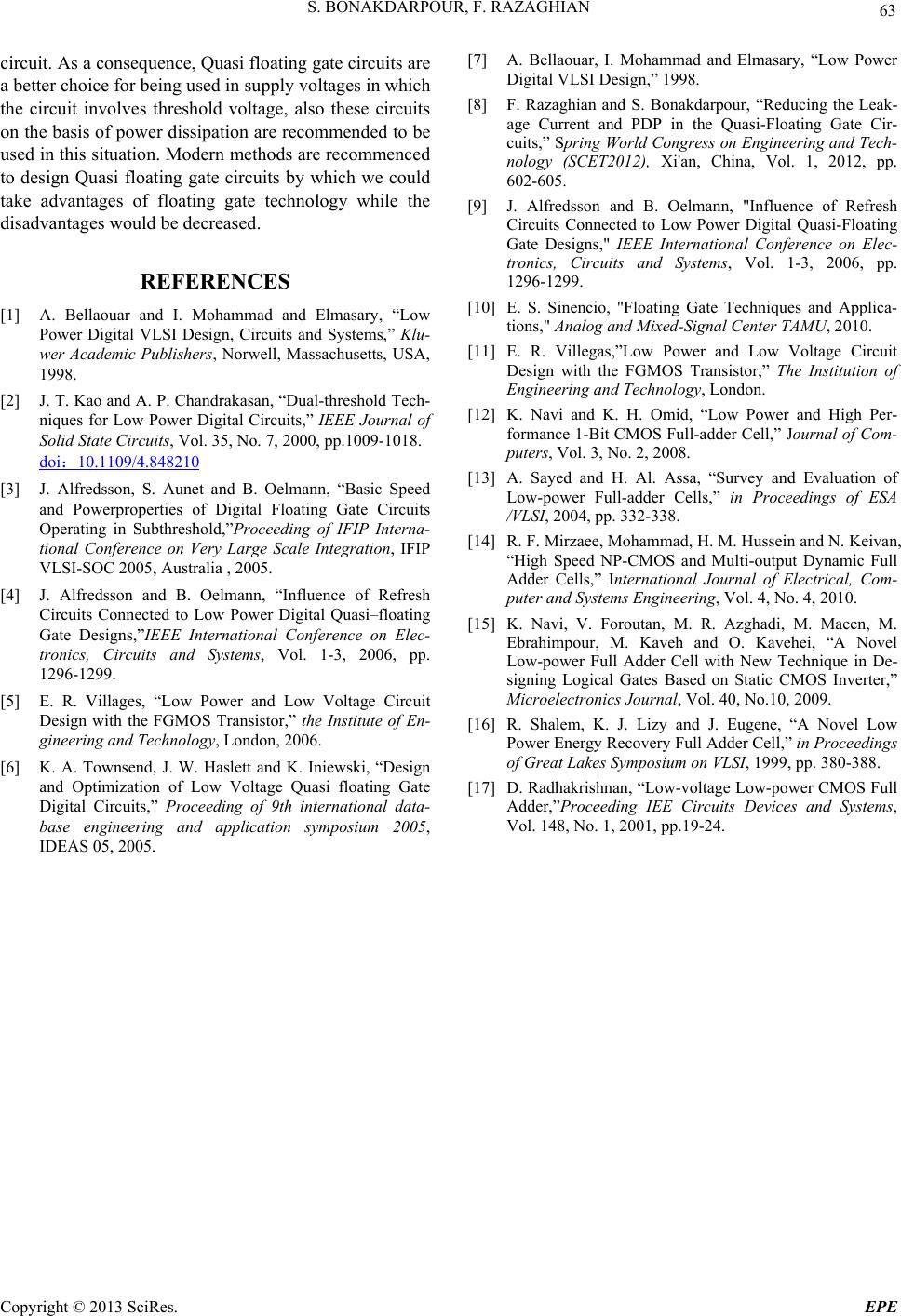
S. BONAKDARPOUR, F. RAZAGHIA N
Copyright © 2013 SciRes. EPE
63
circuit. As a consequence, Quasi floating gate circuits are
a better choice for being used in supply vo ltages in which
the circuit involves threshold voltage, also these circuits
on the basis of power dissipation are recommended to be
used in this situation. Modern methods are recommenced
to design Quasi floating gate circuits by which we could
take advantages of floating gate technology while the
disadvantages would be decreased.
REFERENCES
[1] A. Bellaouar and I. Mohammad and Elmasary, “Low
Power Digital VLSI Design, Circuits and Systems,” Klu-
wer Academic Publishers, Norwell, Massachusetts, USA,
1998.
[2] J. T. Kao and A. P. Chandrakasan, “Dual-threshold Tech-
niques for Low Power Digital Circuits,” IEEE Journal of
Solid State Circuits, Vol. 35, No. 7, 2000, pp.1009-1018.
doi:10.1109/4.848210
[3] J. Alfredsson, S. Aunet and B. Oelmann, “Basic Speed
and Powerproperties of Digital Floating Gate Circuits
Operating in Subthreshold,”Proceeding of IFIP Interna-
tional Conference on Very Large Scale Integration, IFIP
VLSI-SOC 2005, Australia , 2005.
[4] J. Alfredsson and B. Oelmann, “Influence of Refresh
Circuits Connected to Low Power Digital Quasi–floating
Gate Designs,”IEEE International Conference on Elec-
tronics, Circuits and Systems, Vol. 1-3, 2006, pp.
1296-1299.
[5] E. R. Villages, “Low Power and Low Voltage Circuit
Design with the FGMOS Transistor,” the Institute of En-
gineering and Technology, London, 2006.
[6] K. A. Townsend, J. W. Haslett and K. Iniewski, “Design
and Optimization of Low Voltage Quasi floating Gate
Digital Circuits,” Proceeding of 9th international data-
base engineering and application symposium 2005,
IDEAS 05, 2005.
[7] A. Bellaouar, I. Mohammad and Elmasary, “Low Power
Digital VLSI Design,” 1998.
[8] F. Razaghian and S. Bonakdarpour, “Reducing the Leak-
age Current and PDP in the Quasi-Floating Gate Cir-
cuits,” Spring World Congress on Engineering and Tech-
nology (SCET2012), Xi'an, China, Vol. 1, 2012, pp.
602-605.
[9] J. Alfredsson and B. Oelmann, "Influence of Refresh
Circuits Connected to Low Power Digital Quasi-Floating
Gate Designs," IEEE International Conference on Elec-
tronics, Circuits and Systems, Vol. 1-3, 2006, pp.
1296-1299.
[10] E. S. Sinencio, "Floating Gate Techniques and Applica-
tions," Analog and Mixed-Signal Center TAMU, 20 1 0 .
[11] E. R. Villegas,”Low Power and Low Voltage Circuit
Design with the FGMOS Transistor,” The Institution of
Engineering and Technology, London.
[12] K. Navi and K. H. Omid, “Low Power and High Per-
formance 1-Bit CMOS Full-adder Cell,” Journal of Com-
puters, Vol. 3, No. 2, 2008.
[13] A. Sayed and H. Al. Assa, “Survey and Evaluation of
Low-power Full-adder Cells,” in Proceedings of ESA
/VLSI, 2004, pp. 332-338.
[14] R. F. Mirzaee, Mohammad, H. M. Hussein and N. Keivan,
“High Speed NP-CMOS and Multi-output Dynamic Full
Adder Cells,” International Journal of Electrical, Com-
puter and Systems Engineering, Vol. 4, No. 4, 2010.
[15] K. Navi, V. Foroutan, M. R. Azghadi, M. Maeen, M.
Ebrahimpour, M. Kaveh and O. Kavehei, “A Novel
Low-power Full Adder Cell with New Technique in De-
signing Logical Gates Based on Static CMOS Inverter,”
Microelectronics Journal, Vol. 40, No.10, 2009.
[16] R. Shalem, K. J. Lizy and J. Eugene, “A Novel Low
Power Energy Recovery Full Adder Cell,” in Proceedings
of Great Lakes Symposium on VLSI, 1999, pp. 380-388.
[17] D. Radhakrishnan, “Low-voltage Low-power CMOS Full
Adder,”Proceeding IEE Circuits Devices and Systems,
Vol. 148, No. 1, 2001, pp.19-24.